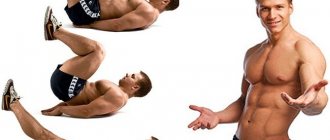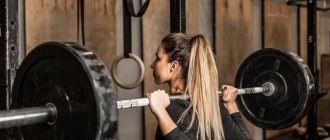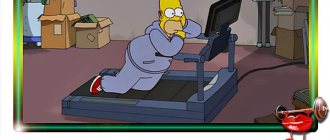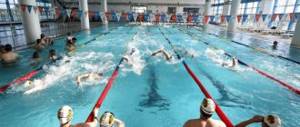Benefits of exercise for older men
After 60 years, and sometimes earlier, as a result of aging of the body, which is accompanied by changes in hormonal levels, men begin to lose muscle mass. Exercising increases physical activity, which prevents rapid loss of muscle tissue. Thanks to properly selected physical exercises, it is possible to get rid of fat deposits, which negatively affect the body at any age.
Fitness helps relieve nervous tension and fights depression well. In old age, psychological health and emotional well-being are important because... prevent exacerbation of chronic diseases. Exercise also affects hormonal levels. A properly selected set of exercises increases testosterone production. This male hormone not only increases sexual desire, but also prevents bone fragility, strengthens the heart, improves metabolism, etc.
Exercises for those over 60: a simple set of exercises
Morning exercises will help you spend the day in a good mood, without complaining of joint pain and other troubles. There are many complexes for the elderly. Let's give one of them.
- When you wake up, soak in bed for some time. This will allow the body to wake up.
- Now stand up and start doing neck stretches. You need to lower your head a little (so as not to cause pain) and rotate your neck in different directions. You need to move like a pendulum.
- Perform slow rotational movements with your head in different directions.
- Gently rotate your neck so that your head touches your shoulders.
- Place your palms on your shoulders and make circular movements in different directions.
- Stretch your arms to the sides, bend them at the elbows and rotate them.
- Inhaling, spread your arms to the sides, lower your torso forward. At the same time, try to arch your back.
- The plie or half squat exercise is useful. Place your heels together and toes apart. Place your hands on your belt. Squat to half.
- If it's not too difficult for you, do full squats while rotating your arms.
- Sit on the mat, spread your legs to the sides. Inhaling, first bend your body towards one leg, then towards the other. Repeat the same with your legs closed.
- Another useful exercise: keep one leg straight, bend the other at the knee. Try to reach a straight limb.
- The starting position is similar, legs bent at the knees. Lower them first to one side, then to the other. While tilting your limbs in one direction or another, pull your head in the opposite direction.
exercises are also recommended as a supplement :
Exercise 1 – breathing
Take a standing position with your legs slightly apart. Lower your arms, then raise them to the ceiling and lower them again, exhaling. Repeat the exercise at least three times.
Exercise 2 – warming up the knee joints
Stand up straight, spread your legs, then squat down a little and place your hands on your knees. Bring your knees in and out several times until they touch each other. After finishing the exercise, you can sit on a chair and rest a little.
Exercise 3 – maintaining posture
An excellent exercise to maintain your posture in old age. Experts recommend performing it not only in the morning, but also throughout the day. You need to lean your back against a cabinet or wall and straighten up. You need to stand in such a position that the back of your head, shoulders, pelvis and heels touch the surface. Stand in this position for about a minute without making any movements. At the same time, you need to inhale and exhale deeply.
Exercise 4 – walking along a line
This exercise will help keep the vestibular apparatus in order. Its essence consists of walking, in which you need to put one leg in front of the other, just as tightrope walkers do. You can walk in this way both forward and backward. To make walking more difficult, you can do it with your eyes closed.
Exercise 5 – walking in place
A very simple exercise, and at the same time very useful for older people. When performing it, your back should be straight. You need to stand up, slightly bend one leg at the knee and lift it, then lower it, do the same for the other leg. Walk in place for a few minutes. You can complement this exercise by swinging your arms to the sides.
An excellent form of physical activity for older people is Nordic walking, which uses special poles. It involves minimal stress on the joints and allows you to safely and efficiently work out the muscles. This is an excellent option for those for whom dynamic activity is contraindicated.
Contraindications
Sports activities that involve intense physical activity have a number of restrictions. It is not recommended to ignore existing contraindications, because the consequences may be negative.
At the age of 60, it is recommended to completely abandon increased physical activity if you have the following health problems:
- recent traumatic brain injury;
- epilepsy;
- malignant neoplasms;
- spinal injuries;
- heart attack;
- pathologies of the heart muscle.
Physical therapy, the program of which is selected by a specialist, may be permitted for some diseases.
After 60 years of age, men should temporarily stop training if their general health deteriorates until the cause of the unpleasant symptoms is determined.
You should reduce the intensity of exercise or completely abandon sports during periods of exacerbation of chronic diseases, colds, flu, etc.
Training after 60 years: strength or power?
If you are 60 years or older, strength training in its classical sense is not the best option for you. The optimal type of training for older people is speed-strength training (power training).
If classic strength training involves performing movements at a slow pace (for example, 3-4 seconds per repetition on the bench press), then speed-strength training means performing exercises at maximum speed.
A number of studies have shown that power is responsible for the ability of older people to cope with such types of daily activities as walking in the park, walking up the stairs, getting up from a chair. Scientists also consider power to be the main ally of functionality.
In 2011, Swiss researchers analyzed several studies and concluded that speed training provides greater functional benefits for older adults than classical strength training.
An example of morning exercises for older men
You can get a boost of vigor and good mood with morning exercises. It is performed immediately after a night's rest. If you feel unwell, you should refrain from exercise.
Morning exercises for men begin with warming up their legs. To do this, sit down, pull your toes forward and hold in this position for 5-8 seconds, and then relax your feet. After 5-6 seconds, the exercise is repeated, but in reverse: you should pull the socks towards you. Your knees should not be bent while performing the exercises. This foot warm-up is performed 10 times.
Without changing body position, begin to perform hand exercises. It is necessary to slowly raise one limb, hold it in this position for 7-8 seconds, and then slowly lower it. The exercise is repeated for the right and left hands alternately (10 times).
In a sitting position, they begin to raise their legs one by one, holding each one in the air for a few seconds. You need to do 10 exercises per limb.
Rotations will help stretch your shoulder joints. The hands are placed on the shoulders and rotated 10 times in each direction. Additionally, you can perform an exercise that involves raising and lowering your shoulders.
While standing, you can bend sideways and forward, lunge, and then move on to rotating your hips. Each exercise is repeated 10 times.
You can complete your morning exercises with a walk. It is recommended to replace jogging at age 60 with race walking.
Iron Health
It would seem, what could be the life priorities of a person at 60 years old? However, every time you see the founder of the World Wrestling Federation, Vince McMahon , it seems that his life is just beginning. His unquenchable energy is transmitted to everyone who surrounds him. No wonder thousands of guys come to him every year. And for everyone, he is not just an idol, but a role model, a philosophical support that helps many make special life decisions.
As long as McMahon has been wrestling, he has been rocking. In 46 years of his hard training, he never missed a single training session, with the exception of a period of injury when he managed to tear both quadriceps while jumping on an opponent from a fence post.
“No, I'm not a bodybuilder. They train for the purpose of competing, and I respect that...”
Very often, McMahon is compared to Arnold Schwarzenegger for his determination and inexhaustible fanaticism. Like, he, just like Arnold, achieved everything alone, without influential patrons behind him. However, Vince does not share this opinion, saying that he, unlike Schwarzenegger, would never trade wrestling for anything else. While Arnold gave up bodybuilding for an acting career.
Vince McMahon himself works out cyclically 4 times a week. He alternates between “hard” and “light” weeks. This training plan is called “cyclic”. Despite his enormous fortune and his own gym near his home, Vince almost never uses exercise equipment in his practice, preferring basic exercises exclusively with free weights. Almost constantly in the off-season, a huge number of young athletes visit him with the aim of training with this unique person. However, many are still shocked not only by the intensity of his programs, but also by the monstrous working weights. It's unlikely that you've ever seen a 60-year-old muscleman leg press 600 kilograms or pull a T-bar weighing 250 kilograms. There’s no need to talk about aerobic training at all: half-hour sprint races are commonplace.
“I always tell young athletes: bodybuilding is a lifelong pursuit.”
Very often McMahon is asked if he is tired of doing this? That, they say, at his age it is necessary to change priorities towards a calmer and more measured way of life. Such questions traditionally baffle him, because is it possible to live differently? Of course, a 20-year-old guy needs a huge biceps much more, however, if you don’t resist, the years will take their toll: health, a sober mind and even the respect of others. As long as you are engaged in bodybuilding, there is nothing to be afraid of.
Vince McMahon's cycling training system. Day 1: Chest + Triceps
Hard training:
| Exercises | Approaches | Repetitions |
| Bench press | 5 | 10, 8, 6, 3, 2 |
| Smith Incline Press | 3 | 10, 8, 8 |
| Information in the “Butterfly” simulator | 3 | 10 |
| Smith Bench Press | 3 | 10 |
| Push ups | 3 | 12 |
| Press down on the block | 3 | 12 |
Easy training:
| Exercises | Approaches | Repetitions |
| Dumbbell Incline Press | 5 | 15, 12, 10, 10, 10 |
| Smith Incline Press | 4 | 10 |
| Bench press | 4 | 10 |
| French press | 3 | 10 |
| Press down on the block | 3 | 15 |
| Bent over arm extension | 3 | 15 |
Day 2: Back + biceps
Hard training:
| Exercises | Approaches | Repetitions |
| Upper chest row | 4 | 15, 10, 8, 8 |
| Bent-over row | 4 | 15, 10, 8, 6 |
| Deadlift in the simulator | 3 | 10 |
| Seated rows | 3 | 10 |
| Standing biceps curl | 3 | 10 |
| Rising on a music stand | 3 | 10 |
| Standing dumbbell raises | 3 | 10 |
Easy training:
| Exercises | Approaches | Repetitions |
| Pull-ups | 4 | 10 |
| Upper chest row | 4 | 10 |
| One arm bent over row | 3 | 10 |
| Shrugs | 3 | 10 |
| Biceps curl with dumbbells | 3 | 10 |
| Biceps curls in the machine | 3 | 10 |
| Cable biceps curls | 3 | 10 |
Day 3: Deltas
Hard training:
| Exercises | Approaches | Repetitions |
| Dumbbell lateral raises | 3 | 10 |
| Seated barbell press | 3 | 10 |
| Reverse dilutions | 3 | 15 |
Easy training:
| Exercises | Approaches | Repetitions |
| Lateral raises on blocks | 3 | 10 |
| Seated bench press | 3 | 10 |
| Barbell row to the chin | 3 | 10 |
Day 4: Legs
Hard training:
| Exercises | Approaches | Repetitions |
| Leg extensions | 3 | 15 |
| Squats | 4 | 10 |
| Leg press | 5 | 8 |
| Leg Curl | 4 | 15 |
| Romanian deadlift | 4 | 15 |
Easy training:
| Exercises | Approaches | Repetitions |
| Seated leg curl | 3 | 10 |
| Leg press | 3 | 10 |
| Lunges | 3 | 10 |
| Leg extension | 3 | 15 |
Features of the program:
- Exercise 4 times a week. Each muscle should rest for at least seven days.
- One week we will lift with maximum weights and intensity, the next week we will reduce the working weights, but increase the overall volume of training.
- Press twice a week.
- Train your calves every third workout.
Training after 60 years: how to train power?
Power training involves performing movements at as fast a pace as possible. However, this type of training should not be confused with training for weightlifters. Power training is a common gym workout that involves lifting weights as fast as you can (with perfect form, of course).
Most studies used machines rather than free weights. The exercises were performed in 2-3 sets for large muscle groups, which were trained 2-3 days a week. The intensity of the training was 70% of the maximum weight that the subjects could lift, which was 8-10 repetitions per set.











